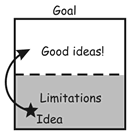By: Jeffrey Baumgartner
When we are trying to dream up ideas for a particular problem, we have a tendency to look at the limitations and focus our ideation on ideas that meet the demands of our limitations. In short, we only consider ideas that come within the “good ideas” portion of our realm of ideas. Ideas that do not make it into the good ideas realm are often rejected immediately.
That is not a good idea! In fact, it is squelching your imagination and restricting the creative potential of your ideas. Instead, when generating ideas, make a note of all of your ideas, regardless of whether they fall in the “good ideas” realm or the “limitations” realm.
Here’s an exercise that can help you to leap beyond your thinking limitations:
 Draw a square on a piece of paper. Immediately above the square, write the word “Goal”. This square represents the realm of ideas for a particular issue or problem. When you generate ideas for the problem, they should fit in the square. The closer those ideas are to your goal, the higher they will sit in the square.
Draw a square on a piece of paper. Immediately above the square, write the word “Goal”. This square represents the realm of ideas for a particular issue or problem. When you generate ideas for the problem, they should fit in the square. The closer those ideas are to your goal, the higher they will sit in the square.
Across the middle of the square, from left to right, draw a dashed line. Below the line, write “limitations”. Above the line write “good ideas, like the illustration on the right.
 Now, take the square you have drawn, add a little star below the dotted line and label it “idea”. Draw an arrow from the star to a point well above the dotted line, like the second illustration on the left.
Now, take the square you have drawn, add a little star below the dotted line and label it “idea”. Draw an arrow from the star to a point well above the dotted line, like the second illustration on the left.
As the illustration shows, you need to take an idea that falls within the limitations realm and modify it in such a way that you bring it into the “good ideas” realm.
Consider, by way of example, a hypothetical group of talented programmers who have recently lost their jobs and are looking for ideas for earning an income. They are all honest people, so when one of them jokingly says, “we could rob a bank”, they all laugh and reject the idea as a joke. Because they are honest, one of their limitations is any money making idea must be legally viable.
Now, consider a more creative group of jobless programmers in the same situation. One of them says, “we could rob a bank.” But this time, instead of rejecting the idea, they try and find ways to bring the idea up from the limitations realm into the good ideas realm. They play with the idea and come up with some interesting alternatives.
“We could make a computer game about robbing banks,” says one programmer.
“Or we could design security software to help banks prevent electronic theft,” says another.
“Or we could offer to analyse banks’ computer systems to search for security holes that could lead to robberies,” says another.
“Or we could provide banks with advice on how to deal with phishing,” says another.
Conclusion
As you can see, by trying to take an idea out of the realm of limitations and into the realm of good ideas, the creative group of programmers comes up with three interesting alternative solutions.
Likewise, when you are trying to find good ideas, do not reject the ones that do not meet your requirements. Rather consider how you can modify those ideas so they do meet your requirements. The result will almost certainly be more creative ideas and a more dynamic way of looking at problems.
By Jeffrey Baumgartner
About the author
 Jeffrey Baumgartner is the author of the book, The Way of the Innovation Master; the author/editor of Report 103, a popular newsletter on creativity and innovation in business. He is currently developing and running workshops around the world on Anticonventional Thinking, a new approach to achieving goals through creativity.
Jeffrey Baumgartner is the author of the book, The Way of the Innovation Master; the author/editor of Report 103, a popular newsletter on creativity and innovation in business. He is currently developing and running workshops around the world on Anticonventional Thinking, a new approach to achieving goals through creativity.
